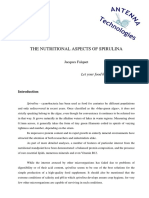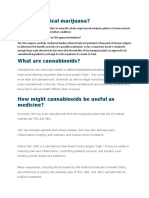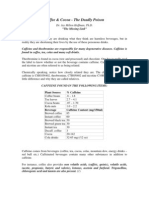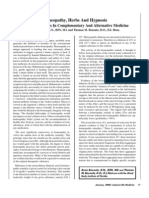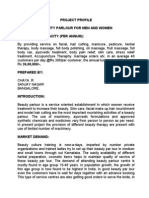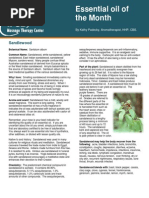Fenugreek
Fenugreek
Uploaded by
2009tamerCopyright:
Available Formats
Fenugreek
Fenugreek
Uploaded by
2009tamerCopyright
Available Formats
Share this document
Did you find this document useful?
Is this content inappropriate?
Copyright:
Available Formats
Fenugreek
Fenugreek
Uploaded by
2009tamerCopyright:
Available Formats
Fenugreek - Wikipedia, the free e...
Page 1
Fenugreek
From Wikipedia, the free encyclopedia
Fenugreek (/fnjrik/; Trigonella foenum-graecum) is an annual plant in the family Fabaceae with leaves consisting of three small obovate to oblong leaflets. It is cultivated worldwide as a semi-arid crop, and its seeds are a common ingredient in dishes from the Indian Subcontinent. It is known as methi in Marathi (), Punjabi () or (), Hindi (), Urdu(), Bengali () and Nepali (), as menthiyam, and venthayam () in Tamil, "uluhaal" () in Sinhala, ShOoT ( ) in Hebrew, (emen tozu) in Turkish, Helba ( )in Arabic and Dari,Shanbelileh ( ) in Persian, menthya () in Kannada, uluwa () in Malayalam, moshoseitaro () or () or () in Greek and menthulu () in Telugu.
Fenugreek
Contents
1 History 2 Production 3 Use 3.1 Cuisine 3.2 Lactation 3.3 Medicinal 4 Seeds 5 Nutritional profile 6 News 7 References 8 External links
Scientific classification Kingdom: Plantae Angiosperms Eudicots Rosids Fabales Fabaceae Trigonella T. foenum-graecum Binomial name Trigonella foenum-graecum
L.[1]
History
Zohary and Hopf note that it is not certain which wild strain of the genus Trigonella gave rise to domesticated fenugreek: they believe it was brought into cultivation in the Near East. Charred fenugreek seeds have been recovered from Tell Halal, Iraq, (carbon dated to 4000 BC) and Bronze Age levels of Lachish and desiccated seeds from the tomb of Tutankhamen.[2] Cato the Elder lists fenugreek with clover and vetch as crops grown to feed cattle.[3]
(unranked): (unranked): (unranked): Order: Family: Genus: Species:
Production
Major fenugreek-producing countries are Afghanistan, Pakistan, India, Iran, Nepal, Bangladesh, Argentina, Egypt, France, Spain, Turkey and Morocco. The largest producer is India, where the major producing states are Rajasthan, Gujarat, Uttarakhand, Uttar Pradesh, Madhya Pradesh, Maharashtra, Haryana, and Punjab Rajasthan accounts for over 80% of India's output.[4][5]
Use
Cuisine
Fenugreek has three culinary uses: as a herb (dried or fresh leaves), as a spice (seeds), and as a vegetable (fresh leaves, sprouts, and microgreens). Sotolon is the chemical responsible for fenugreek's distinctive sweet smell. Distinctive cuboid-shaped, yellow-to-amber colored fenugreek seeds are frequently encountered in the cuisines of the Indian subcontinent. They are used in the preparation of pickles, vegetable dishes, daals, and spice mixes such as panch phoron and sambar powder. They are used both whole and in powdered form and are often roasted to reduce their bitterness and enhance their flavor.[6] Fresh fenugreek leaves are an ingredient in some Indian curries. The sprouted seeds and microgreens are used in salads. When harvested as microgreens, fenugreek is known as Samudra Methi in Maharashtra, especially in and around Mumbai, where it is often grown near the sea in the sandy tracts, hence the name (Samudra, "ocean" in Sanskrit).[7] Samudra Methi is also grown in dry river beds in the Gangetic plains. When sold as a vegetable in India, the young plants are harvested with their roots still attached. Any remaining soil is washed off to extend their shelf life. They are then sold in small bundles in the markets and bazaars.
http://en.wikipedia.org/wiki/Fenu...
16/01/2014
6:20:05 PM
Fenugreek - Wikipedia, the free e...
Page 2
In Persian cuisine, fenugreek leaves are called ( shanbalile). They are the key ingredient and one of several greens incorporated into ghormeh sabzi and Eshkeneh, often said to be the Iranian national dishes. Fenugreek is used in Eritrean and Ethiopian cuisine.[8] The word for fenugreek in Amharic is abesh (or abish), and the seed is used in Ethiopia as a natural herbal medicine in the treatment of diabetes.[8] Yemenite Jews following the interpretation of Rabbi Salomon Isaacides, Rashi of Talmd, believe fenugreek, which they call hilbeh, hilba, helba, or halba ( )is the Talmudic Rubia () . They use it to produce a sauce also called hilbeh,[9] reminiscent of curry. It is consumed daily and ceremoniously during the meal of the first and/or second night of Rosh Hashana (Jewish New Year).[10]
Lactation
Fenugreek seeds are thought to be a galactagogue, often used to increase milk supply in lactating mothers.[11]
Medicinal
A June 2011 study at the Australian Centre for Integrative Clinical and Molecular Medicine found that men aged 25 to 52 who took a fenugreek extract twice daily for six weeks scored 25% higher on tests gauging libido levels than those who took a placebo.[12][13] [14][15] Fenugreek seeds contain a high level of palmitoylethanolamide, more than 25%.[16] Palmitoylethanolamide is an endogenous lipid, which can be found in many plants and animals, but never in such high concentrations. Palmitoylethanolamide has been proven to be a natural analgesic and anti-inflammatory compound.
Seeds
Fenugreek seed is widely used as a galactagogue (milk producing agent) by nursing mothers to increase inadequate breast milk supply. Studies have shown that it is a potent stimulator of breast milk production and its use was associated with increases in milk production.[17] It can be found in capsule form in many health food stores.[18] Several human intervention trials demonstrated that the antidiabetic effects of fenugreek seeds ameliorate most metabolic symptoms associated with type-1 and type-2 diabetes in both humans and animals by reducing serum glucose and improving glucose tolerance.[19][20]
Nutritional profile
Fenugreek leaves contain the following nutrients per 100 g of edible portion:[21][22] Carbohydrates: 6.0 g Protein: 4.4 g Fat: 0.9 g Minerals: 1.5 g Calcium: 395 mg Phosphorus: 51 mg Iron: 1.93 mg Total energy: 49 kcal
Dried fenugreek seed
News
In February 2009, the International Frutarom Corporation factory in North Bergen, New Jersey was found to be the source of a mysterious maple syrup aroma that had been reported as occasionally drifting over New York City since 2005. The odor was found to be from sotolon, an ester in fenugreek seeds. No health risks have been found.[23] Fenugreek seeds imported from Egypt in 2009 and 2010 have been linked to outbreaks of Escherichia coli O104:H4 in Germany and France, causing 50 deaths in 2011.[24][25]
References
1. ^ "Trigonella foenum-graecum information from NPGS/GRIN" (http://www.ars-grin.gov/cgibin/npgs/html/taxon.pl?40421). www.ars-grin.gov. Retrieved 2008-03-13. 2. ^ Daniel Zohary and Maria Hopf (2000). Domestication of plants in the Old World (Third ed.). Oxford: Oxford University Press. p. 122. 3. ^ Cato the Elder. De Agri Cultura. p. 27. 4. ^ V. A. Parthasarathy, K. Kandinnan and V. Srinivasan (ed.). "Fenugreek". Organic Spices. New India Publishing Agenies. p. 694. 5. ^ Statistics (http://dacnet.nic.in/spices/index_frame.asp) 6. ^ "Fenugreek recipes" (http://www.bbc.co.uk/food/fenugreek). BBC Food.
http://en.wikipedia.org/wiki/Fenu...
16/01/2014
6:20:05 PM
Fenugreek - Wikipedia, the free e...
Page 3
7. ^ "How to Series: Growing Methi 15. (Fenugreek)" (http://fenugreeklove.wordpress.com/2009/11/16/growingmethi-fenugreek/). A blog called "Fenugreek Love". Retrieved 2 March 2011. 8. ^ a b Gall, Alevtina; Zerihun Shenkute (November 3, 2009). 16. "Ethiopian Traditional and Herbal Medications and their Interactions with Conventional Drugs" (http://ethnomed.org/clinical/pharmacy/ethiopian-herbdrug-interactions). EthnoMed. University of Washington. 17. Retrieved January 27, 2011. 9. ^ "Hilba (Fenugreek_paste)" (http://www.cookipedia.co.uk/wiki/index.php/Hilba_ (Fenugreek_paste)). cookipedia.co.uk. 10. ^ This is based on the assumption that the Aramaic name corresponds to it. (Karetot 6a; Horiyot 12a) Rabbenu Nissim at the end of Rosh Hashana, citing the custom of R Hai Gaon. This follows Rashi's translation of , cited as authoritative 18. by Tur and Shulchan Aruch OC 583:1. But Avudraham interprets as black-eyed peas. 11. ^ Chantry, Caroline J.; Howard, Cynthia R.; Montgomery, 19. Anne; Wight, Nancy (2004). Use of galactogogues in initiating or augmenting maternal milk supply (http://web.archive.org/web/20070628052457/http://www.bfmed.org/acefiles/protocol/prot9galactogoguesEnglish.pdf) (PDF). ABM 20. protocols, Protocol#9. The Academy Of Breastfeeding Medicine. Archived from the original (http://www.bfmed.org/acefiles/protocol/prot9galactogoguesEnglish.pdf) on 2007-06-28. "Supported in part by a grant from the Maternal and Child Health Bureau, Department of Health and Human Services." 21. 12. ^ John Thorpe (2011-06-20). "Get it to the Fenugreek? How Curry Can Seed Your Sex Life" (http://www.sfgate.com/cgibin/article.cgi?f=/g/a/2011/06/20/benzinga1183453.DTL). San 22. Francisco Chronicle. 13. ^ Amanda Chan (2011-06-20). "Fenugreek: A Spice To Spice Things Up In The Bedroom" (http://www.huffingtonpost.com/2011/06/20/fenugreeklibido_n_880596.html). Huffington Post. 23. 14. ^ Steels, E.; Rao, A.; Vitetta, L. (2011). "Physiological Aspects of Male Libido Enhanced by Standardized Trigonella foenumgraecum Extract and Mineral Formulation". Phytotherapy 24. Research: n/a. doi:10.1002/ptr.3360 (http://dx.doi.org/10.1002%2Fptr.3360). PMID 21312304 (//www.ncbi.nlm.nih.gov/pubmed/21312304). 25.
^ Basch, E; Ulbricht, C; Kuo, G; Szapary, P; Smith, M (2003). "Therapeutic applications of fenugreek" (http://www.altmedrev.com/publications/8/1/20.pdf). Altern Med Rev 8 (1): 2027. PMID 12611558 (//www.ncbi.nlm.nih.gov/pubmed/12611558). ^ Kamal Kishore Pande et al Limonene dominates the Phytochemistry of Trigonella foenum-graceum in Nature, Nature and Science, 2011;9(5) http://www.sciencepub.net/nature) ^ Turkylmaz, C.; Onal, E.; Hirfanoglu, I. M.; Turan, O.; Ko, E.; Ergenekon, E.; Atalay, Y. L. Z. (2011). "The Effect of Galactagogue Herbal Tea on Breast Milk Production and ShortTerm Catch-Up of Birth Weight in the First Week of Life". The Journal of Alternative and Complementary Medicine 17 (2): 139142. doi:10.1089/acm.2010.0090 (http://dx.doi.org/10.1089%2Facm.2010.0090). PMID 21261516 (//www.ncbi.nlm.nih.gov/pubmed/21261516). ^ "All About Fenugreek" (http://www.breastfeeding.com/all_about/all_about_fenugreek.html). breastfeeding.com. ^ Sharma, RD; Raghuram, TC; Rao, NS (1990). "Effect of fenugreek seeds on blood glucose and serum lipids in type I diabetes". European journal of clinical nutrition 44 (4): 3016. PMID 2194788 (//www.ncbi.nlm.nih.gov/pubmed/2194788). ^ Gupta, A; Gupta, R; Lal, B (2001). "Effect of Trigonella foenum-graecum (fenugreek) seeds on glycaemic control and insulin resistance in type 2 diabetes mellitus: a double blind placebo controlled study". J Assoc Physicians India 49: 1057 61. PMID 11868855 (//www.ncbi.nlm.nih.gov/pubmed/11868855). ^ C.Gopalan, B.V. Ramasastri and S.C. Balasubramaniyam. Nutritive value of Indian food. National Institute of Nutrition, ICMR Hydrabad. ^ Sharma, RD; Raghuram, TC; Rao, NS (1990). "Effect of fenugreek seeds on blood glucose and serum lipids in type I diabetes". European Journal of Clinical Nutrition 44 (4): 301 6. PMID 2194788 (//www.ncbi.nlm.nih.gov/pubmed/2194788). ^ "Mayor reveals source of syrup smell |" (http://abclocal.go.com/wabc/story? section=news/local&id=6642803). abclocal.go.com. ^ "E. coli outbreaks linked to Egypt" (http://www.bbc.co.uk/news/health-13973002). BBC News. 2011-06-30. ^ McKenna, Maryn (2011-07-07). "E. coli: A Risk for 3 More Years From Who Knows Where" (http://www.wired.com/wiredscience/2011/07/e-coli-3years/). Wired.
External links
Fenugreek Seeds for Healthy Shiny Hair (http://readanddigest.com/fenugreek-seeds-for-healthy-shiny-hair/) Read and Digest Fenugreek (http://gernot-katzers-spice-pages.com/engl/Trig_foe.html?style=flow), Gernot Katzer's spice dictionary About Herbs, Botanicals & Other Products (http://www.mskcc.org/mskcc/html/11570.cfm), Memorial Sloan-Kettering Cancer Center Encyclopedia of Spices (http://www.theepicentre.com/Spices/fenugree.html) Retrieved from "http://en.wikipedia.org/w/index.php?title=Fenugreek&oldid=590117750" Categories: Trifolieae Edible legumes Iraqi cuisine Leaf vegetables Medicinal plants Nitrogen-fixing crops Plants used in traditional Chinese medicine Spices Plants described in 1753 This page was last modified on 10 January 2014 at 19:40. Text is available under the Creative Commons Attribution-ShareAlike License; additional terms may apply. By using this site, you agree to the Terms of Use and Privacy Policy. Wikipedia is a registered trademark of the Wikimedia Foundation, Inc., a non-profit organization.
http://en.wikipedia.org/wiki/Fenu...
16/01/2014
6:20:05 PM
You might also like
- Hoxsey BookDocument235 pagesHoxsey BookMichael Markuson100% (2)
- An Insight Into Plants Vol 1 2 Rajan Sankaran.00229 2Document6 pagesAn Insight Into Plants Vol 1 2 Rajan Sankaran.00229 2Shubhaprada S Gothe0% (2)
- Book Review of "Survival - The Mollusc" by DR Sudha BanerjeeDocument2 pagesBook Review of "Survival - The Mollusc" by DR Sudha BanerjeeHomoeopathic PulseNo ratings yet
- Fact Sheet Anti Candida DietDocument4 pagesFact Sheet Anti Candida DietPrabaixar2No ratings yet
- Azadirachta Indica: (NEEM)Document23 pagesAzadirachta Indica: (NEEM)Michel Adam100% (1)
- Homoeopathic Self Healing Guide For Beginners Shiv DuaDocument5 pagesHomoeopathic Self Healing Guide For Beginners Shiv DuamoumonaNo ratings yet
- Colo Vada Plus Hand OutDocument2 pagesColo Vada Plus Hand OutAnurag SinghNo ratings yet
- Unit 5 Natural Health Healing SyllabusDocument4 pagesUnit 5 Natural Health Healing Syllabusapi-484361035100% (1)
- 2019 Introductory Herbal Course Outline1Document6 pages2019 Introductory Herbal Course Outline1Erick Lopez100% (3)
- Otc Drug Drug InteractionsDocument3 pagesOtc Drug Drug InteractionsDavid HosamNo ratings yet
- Fenugreek On DiabetesDocument3 pagesFenugreek On DiabetesDr Dushyant Kamal DhariNo ratings yet
- Nutritional Aspects of Spirulina PDFDocument25 pagesNutritional Aspects of Spirulina PDFnaniyagamiNo ratings yet
- Herbs in Dentistry: ReviewarticleDocument10 pagesHerbs in Dentistry: ReviewarticleYousuf AdamNo ratings yet
- GalenicalsDocument21 pagesGalenicalsVIJAY KUMAR TIRUKKACHI0% (1)
- What Is Medical Marijuana?Document11 pagesWhat Is Medical Marijuana?ZAARA ADAMSNo ratings yet
- Essential Drug ListDocument40 pagesEssential Drug ListSuresh DhunganaNo ratings yet
- Health Psychology Assignment (MA201477)Document7 pagesHealth Psychology Assignment (MA201477)Syeda DaniaNo ratings yet
- Coriander (Corindrum Sativum L) and Its Bioactive ConstituentsDocument19 pagesCoriander (Corindrum Sativum L) and Its Bioactive ConstituentsFirda AuliyaNo ratings yet
- 5 Simple Steps To Cure IBS Without Drugs - Dr. Mark HymanDocument11 pages5 Simple Steps To Cure IBS Without Drugs - Dr. Mark HymanrobustnetNo ratings yet
- AVERRHOA CARAMBOLA Linn. Averrhoa Pentranda BlancoDocument2 pagesAVERRHOA CARAMBOLA Linn. Averrhoa Pentranda Blancodniesse_asisNo ratings yet
- Grapefruit: Name: Grapefruit Scientific Name: Citrus Paradisi Family: RutaceaeDocument20 pagesGrapefruit: Name: Grapefruit Scientific Name: Citrus Paradisi Family: Rutaceae12tribeNo ratings yet
- AHCC - Woodlands Patients GuideDocument80 pagesAHCC - Woodlands Patients GuidecrisperezNo ratings yet
- Alstonine, Flavopereirine, Sempervirine, Serpentine, Pao Pereira, RauwolfiaDocument9 pagesAlstonine, Flavopereirine, Sempervirine, Serpentine, Pao Pereira, RauwolfiaLeonardo NgoveneNo ratings yet
- The Real Miracle NutrientDocument3 pagesThe Real Miracle Nutrientcharismasystemsltd100% (1)
- Get Orthomolecular Medicine - Vitamin C: The Real Story, the Remarkable and Controversial Healing Factor Steve Hickey PDF ebook with Full Chapters NowDocument37 pagesGet Orthomolecular Medicine - Vitamin C: The Real Story, the Remarkable and Controversial Healing Factor Steve Hickey PDF ebook with Full Chapters Nowbilkefelson100% (4)
- QB Herbal DetoxificationDocument19 pagesQB Herbal Detoxificationtomoe hotaru100% (1)
- Antibiotics CompiledDocument30 pagesAntibiotics CompiledJoanne Chu100% (1)
- Caffeine and Theobromine Content of Selected Hershey's ChocolateDocument2 pagesCaffeine and Theobromine Content of Selected Hershey's ChocolateJude PaxmrosyNo ratings yet
- Hand Book On Neem & Allied ProductsDocument11 pagesHand Book On Neem & Allied ProductsBala Ratnakar KoneruNo ratings yet
- PeritonitisDocument4 pagesPeritonitislilaningNo ratings yet
- 1 Relationship of VItamins FinalDocument9 pages1 Relationship of VItamins FinalRajkumar YadavNo ratings yet
- Chlorella Benefits & InformationDocument2 pagesChlorella Benefits & Informationcinefil70No ratings yet
- Wallach Published WorksDocument4 pagesWallach Published Worksmichaelpannone100% (2)
- Constac For Constipation Treatment by Healing Hands HerbsDocument25 pagesConstac For Constipation Treatment by Healing Hands HerbsHealing Hands Clinic Pune100% (2)
- Naturopathic Principles Naturopathic Principles: Vis Medicatrix Naturae)Document10 pagesNaturopathic Principles Naturopathic Principles: Vis Medicatrix Naturae)sohailnoreen5062No ratings yet
- Prevention Diet Nutrition Rules To Follow: DON'T: DODocument2 pagesPrevention Diet Nutrition Rules To Follow: DON'T: DOSamantha NaylorNo ratings yet
- From DR Mark Sircus Are ADocument5 pagesFrom DR Mark Sircus Are AMihaela85No ratings yet
- Cholesterol PDFDocument32 pagesCholesterol PDFAkshad PatilNo ratings yet
- 20 Questions For Your OncologistDocument29 pages20 Questions For Your OncologistDaniel SimionNo ratings yet
- 5 CAM RevisedDocument203 pages5 CAM Revisedkc_teodoro_1No ratings yet
- DR Stephen Mak Treats Terminal Ill Cancer Patients byDocument2 pagesDR Stephen Mak Treats Terminal Ill Cancer Patients byCarlo Santi Bayabay100% (1)
- Foods & Beverages High in Oxalates: FruitsDocument2 pagesFoods & Beverages High in Oxalates: Fruitswo loyaNo ratings yet
- Kid's Health: Dr. John BergmanDocument39 pagesKid's Health: Dr. John BergmanAndrew FongNo ratings yet
- CandidaDocument1 pageCandidalopansNo ratings yet
- Technology FoodDocument5 pagesTechnology FoodBarnali DuttaNo ratings yet
- Sneakpeek Recipes 8 PDFDocument12 pagesSneakpeek Recipes 8 PDFValerio Gabriel Moya TellezNo ratings yet
- The Budwig Diet PlanDocument3 pagesThe Budwig Diet PlanxniciNo ratings yet
- Single DeadliestDocument21 pagesSingle DeadliestNatasha MyersNo ratings yet
- High Blood PressureDocument2 pagesHigh Blood PressureMuhammad NaveedNo ratings yet
- The 7 Pillars of Health EbookDocument34 pagesThe 7 Pillars of Health EbookbrghtcrystlNo ratings yet
- Adaptogen BrochureDocument4 pagesAdaptogen BrochureMark Two-ElevenNo ratings yet
- Fight Cancer PDF PDFDocument6 pagesFight Cancer PDF PDFTushar Varshney100% (1)
- Herbs For CancerDocument5 pagesHerbs For CancerTorentSpyNo ratings yet
- Black CuminDocument45 pagesBlack CuminPeter MangalukiNo ratings yet
- Plants STEROIDSDocument16 pagesPlants STEROIDSstranger13790No ratings yet
- List of HerbsDocument21 pagesList of HerbsJohnWWNo ratings yet
- Clinical Uses of Melatonin in PediatricsDocument14 pagesClinical Uses of Melatonin in PediatricsKarl Emmanuel L. TulioNo ratings yet
- ChildhoodDocument23 pagesChildhoodkrissyNo ratings yet
- Kubios HRV, Users Guide 2.1 PDFDocument44 pagesKubios HRV, Users Guide 2.1 PDFEliseoIslasNo ratings yet
- Anti Diabetic Medicinal PlantsDocument6 pagesAnti Diabetic Medicinal PlantsChaitu1987100% (1)
- Spirulina and ChlorellaDocument5 pagesSpirulina and Chlorellalukasz27r100% (1)
- Major Antinutrients Found in Plant Protein SourcesDocument6 pagesMajor Antinutrients Found in Plant Protein Sourcesgiannidiet100% (1)
- Coffee Cocoa The Deadly PoisonDocument7 pagesCoffee Cocoa The Deadly PoisonNishant Singh100% (1)
- Milk Thistle Identification and UsesDocument16 pagesMilk Thistle Identification and UsesLes BennettNo ratings yet
- Fenugreek An OverviewDocument19 pagesFenugreek An OverviewArun EbenezerNo ratings yet
- Autopathic Bottle Instruction BreathDocument1 pageAutopathic Bottle Instruction BreathjivinaNo ratings yet
- Basics of Ayurvedic Pharmacology (Dravya Guna Vignana)Document3 pagesBasics of Ayurvedic Pharmacology (Dravya Guna Vignana)SN Wijesinhe100% (1)
- History of PharmacognosyDocument5 pagesHistory of Pharmacognosyasma nizamNo ratings yet
- Manual of Veterinary HomeopathyDocument308 pagesManual of Veterinary Homeopathycristinacaetano9355100% (4)
- Lu NotesDocument1 pageLu Notesray72roNo ratings yet
- Calamus Acorus Calamus: Common NamesDocument5 pagesCalamus Acorus Calamus: Common NamestayyabNo ratings yet
- BAFENG (M-LE-8) : Eight WindsDocument1 pageBAFENG (M-LE-8) : Eight Windsray72roNo ratings yet
- Alternative and Complementary Medicine: AlterativeDocument9 pagesAlternative and Complementary Medicine: AlterativemuhammadriazNo ratings yet
- DR - Pouse Poulose Puthussery Sharing Knowledge of Ayurvedic Science and TreatmentDocument27 pagesDR - Pouse Poulose Puthussery Sharing Knowledge of Ayurvedic Science and Treatmentmylu_homeNo ratings yet
- Homeopathy, Herbs and HypnosisDocument8 pagesHomeopathy, Herbs and Hypnosisalfaqir fikri100% (4)
- Wuchu Bl-5: Fifth PlaceDocument1 pageWuchu Bl-5: Fifth Placeray72roNo ratings yet
- MCQS in Materia Medica - Homeopathy ResourceDocument3 pagesMCQS in Materia Medica - Homeopathy ResourceShiv Om100% (1)
- Project Profile For Beauty Parlour (Chaya)Document5 pagesProject Profile For Beauty Parlour (Chaya)Arham Jain50% (2)
- Ayurvedic CompanyDocument5 pagesAyurvedic CompanyHarshwardhan SinghNo ratings yet
- Medicine & Health - Scribd CollectionDocument26 pagesMedicine & Health - Scribd CollectionRaduNo ratings yet
- Department of AYUSH: (Ayurveda, Yoga and Naturopathy, Unani, Siddha and Homoeopathy)Document3 pagesDepartment of AYUSH: (Ayurveda, Yoga and Naturopathy, Unani, Siddha and Homoeopathy)Sreedhar TirunagariNo ratings yet
- Essential Oil of The Month: SandlewoodDocument2 pagesEssential Oil of The Month: SandlewoodAnumeha Jindal0% (1)
- Case TakingDocument45 pagesCase TakingHomoeopath Aamir Saleem100% (1)
- 10 Medicinal Plants in The Philippines Endorsed by DOHDocument1 page10 Medicinal Plants in The Philippines Endorsed by DOHXXX YYYNo ratings yet
- Revised Monographs in USP34NF29Document1 pageRevised Monographs in USP34NF29amin138irNo ratings yet
- LECTURE 2: Organon 2 The Highest Ideal of A CureDocument8 pagesLECTURE 2: Organon 2 The Highest Ideal of A CureOana SandraNo ratings yet
- National Institute Under Department of AyushDocument1 pageNational Institute Under Department of AyushAnkush BhartiNo ratings yet
- Screening of Medicinal Plants For Secondary MetabolitesDocument6 pagesScreening of Medicinal Plants For Secondary MetabolitesFira Annisa100% (2)











